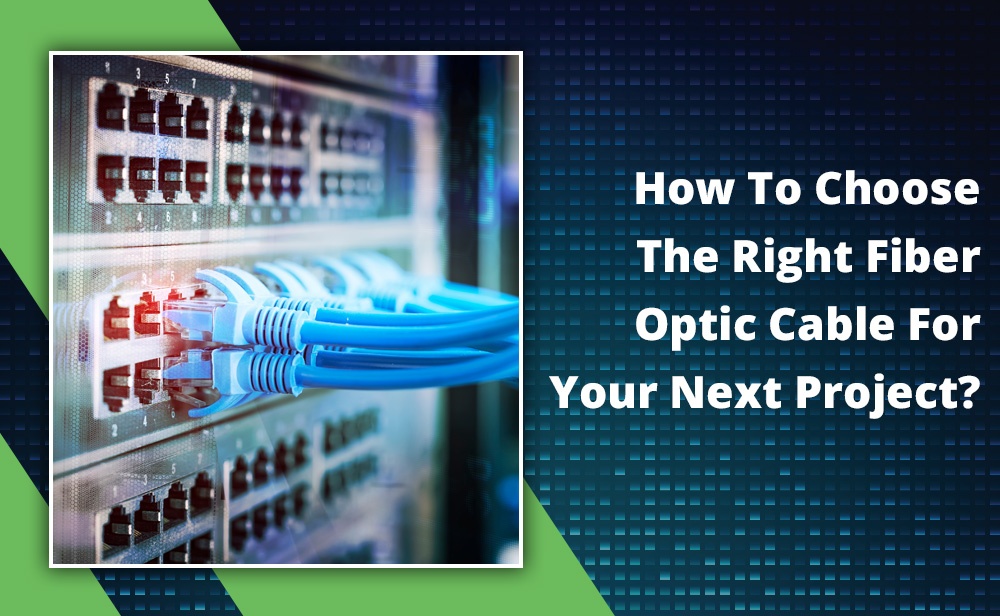How To Choose The Right Fiber Optic Cable For Your Next Project?

If you’re planning to get a new network installed to improve the speed and quality of your business and services, you may want to consider getting a fiber optic cable. Fiber optic cables transmit a signal in the form of light through a very thin glass strand. It can transmit signals for significant distances, whether in local areas or for a few kilometers in a wide area network. Nowadays, this medium is preferred due to its capability to transmit higher bandwidths of data at lightning speeds to longer distances. Another significant advantage of using fiber optics is its immunity to various radio interference. This makes it a superior product in the telecommunication industry.
However, as there are several fiber optic options available today, it can be challenging to decide which is the best for you. To help you make the right decision for your needs, ExcelLinx Communications has explained some of your choices. Keep reading to know what they are and how they can help you with your network requirements for your next project.
1. Indoor vs. outdoor cables
A significant reason why you would choose an indoor cable over outdoor cable is because of the environment you want to use it in. Outdoor cables are mainly used in high moisture areas, as these cables can protect themselves from harsh weather conditions, rodents, etc. On the other hand, indoor cables are tightly buffered cables which are easier to work with. Outdoor cables come in different versions like direct burial cables or armored cables. The type you require depends on your surroundings. That said, in some cases, depending on the areas we deal with, outdoor cables could be used inside a building to protect it from various threats (for example, rats).
2. Single-mode or multimode fiber optic cables
There are generally two types of fiber optic cables: single-mode and multimode fiber cables. Single-mode optical fibers typically have a core diameter of 9 µm and requires laser technology to send and receive data. It can carry a signal for miles, which makes it ideal for telephone and cable television providers. Whereas, multimode fiber permits the signal to travel in multiple modes, or pathways, along the inside of its glass strand or core. A multimode cable is generally used to cover shorter distances. It comes with a core diameter of 62.5 µm or 50 µm. Although the core sizes of single-mode fiber and multimode fiber differ significantly, both fiber types end up with an outer diameter of about 250 µm.
3. Plenum and non-plenum cables
Plenum or fire-rated cables are required to run in plenum spaces as per building code. In the case of non-plenum space, riser cables can also be used. Just make sure to check your local building codes before deciding between plenum or riser cables.
4. Loose tube, ribbon, or aerial fiber optics
Loose tube fiber optic cables are composed of several fibers together inside a small plastic tube, which in turn is wound around a central strength member and jacketed, providing a small, high fiber count cable. These cables are generally water-resistant and are used in outside plants or establishments.
With ribbon fiber optic cables, you’ll receive the highest packing density as all the fibers are laid out in rows (typically of twelve fibers) and placed on top of each other. Some cable designs use a slotted core with up to six of these 144 fiber ribbon assemblies for 864 fibers in one cable. As they are outside plant cables, they are generally gel-filled for water blocking and protection.
When it comes to aerial fiber optic cables, you’ll notice that they can be lashed to a messenger or have metal or aramid strength members to make them self-supportive. Aerial cables are typically used for outside installation on poles.
As you can see, choosing a fiber optic cable depends on your needs and surroundings. To ensure you make the right choice, it is essential to understand what you need. If you’re unsure of your requirements, consult a licensed fiber optic technician or a professional fiber optic company like ExcelLinx Communications to save yourself time and resources.
For more information on fiber optic solutions, reach out to the team at ExcelLinx Communications. We are a network and cabling company in Toronto, and we provide a broad range of network infrastructure solutions. Our clients mainly include data centers, network infrastructure, converged media and audiovisual, business telephony, security, and nationwide IT project rollouts. We are professionally represented by certified installers and service delivery partners across the country to corporate houses that rely on quality service. Through our partners, we also provide customized, end-to-end solutions that build and maintain the communication backbone of our clients’ businesses.
To learn more about our network solutions, please click here or get in touch with us by clicking here.